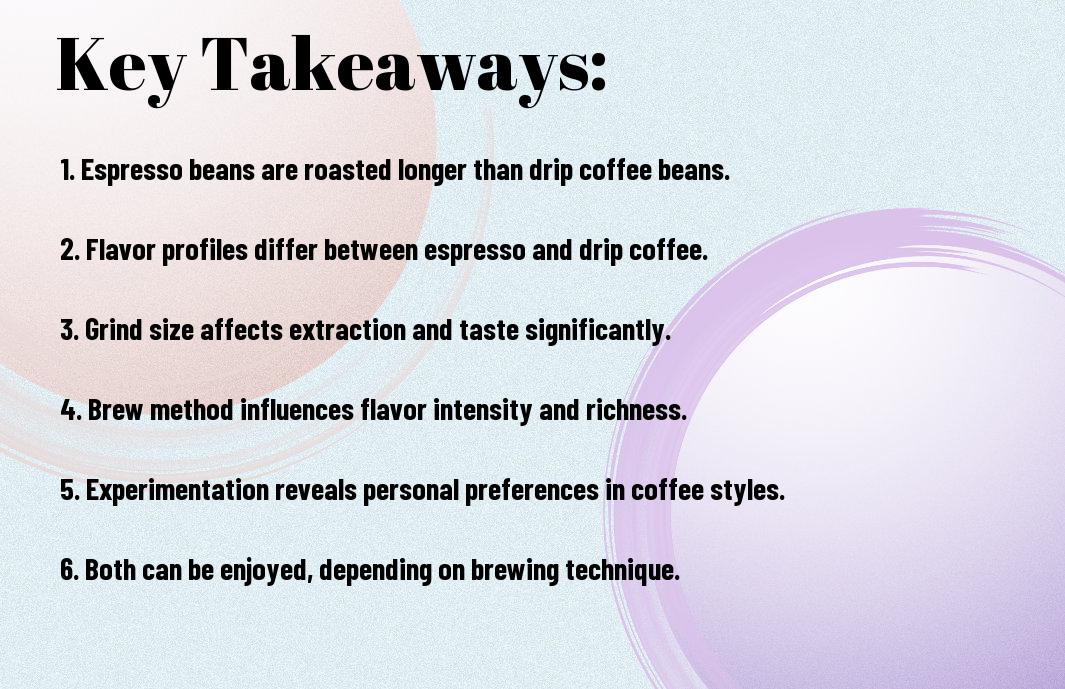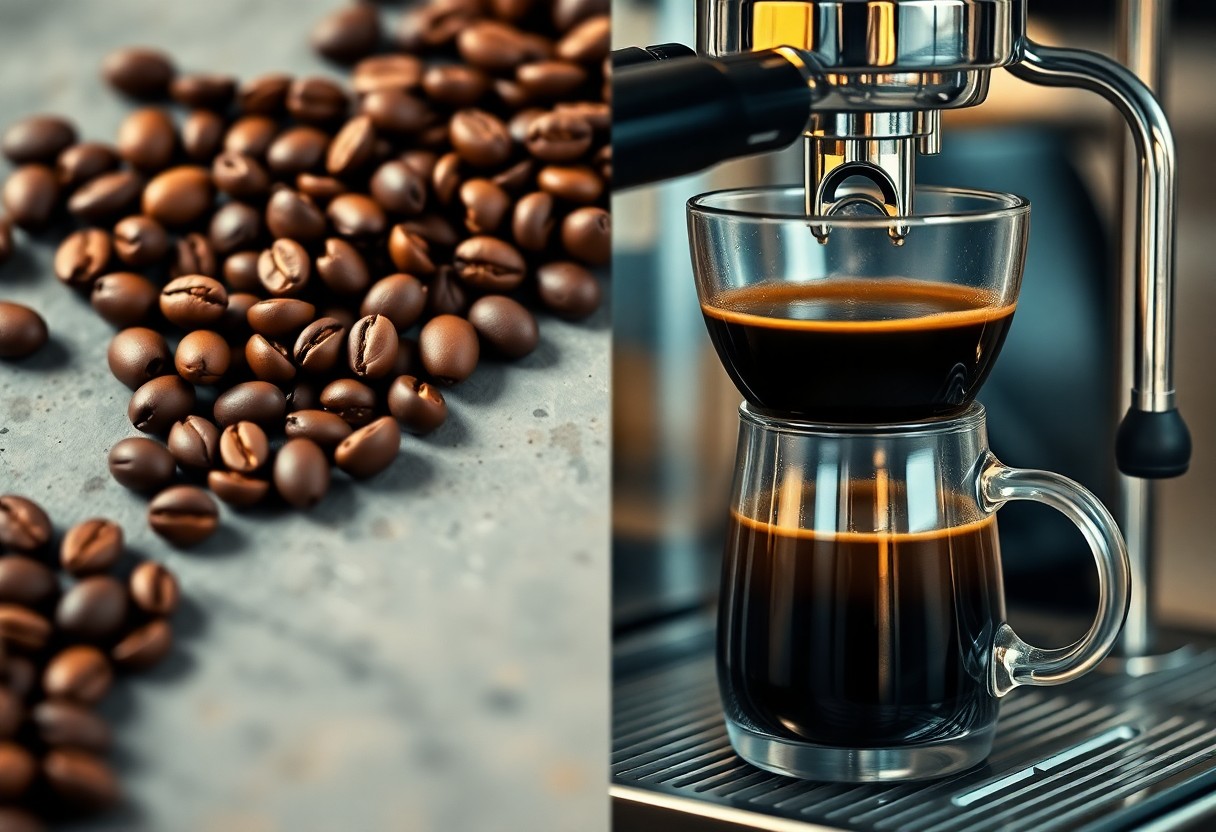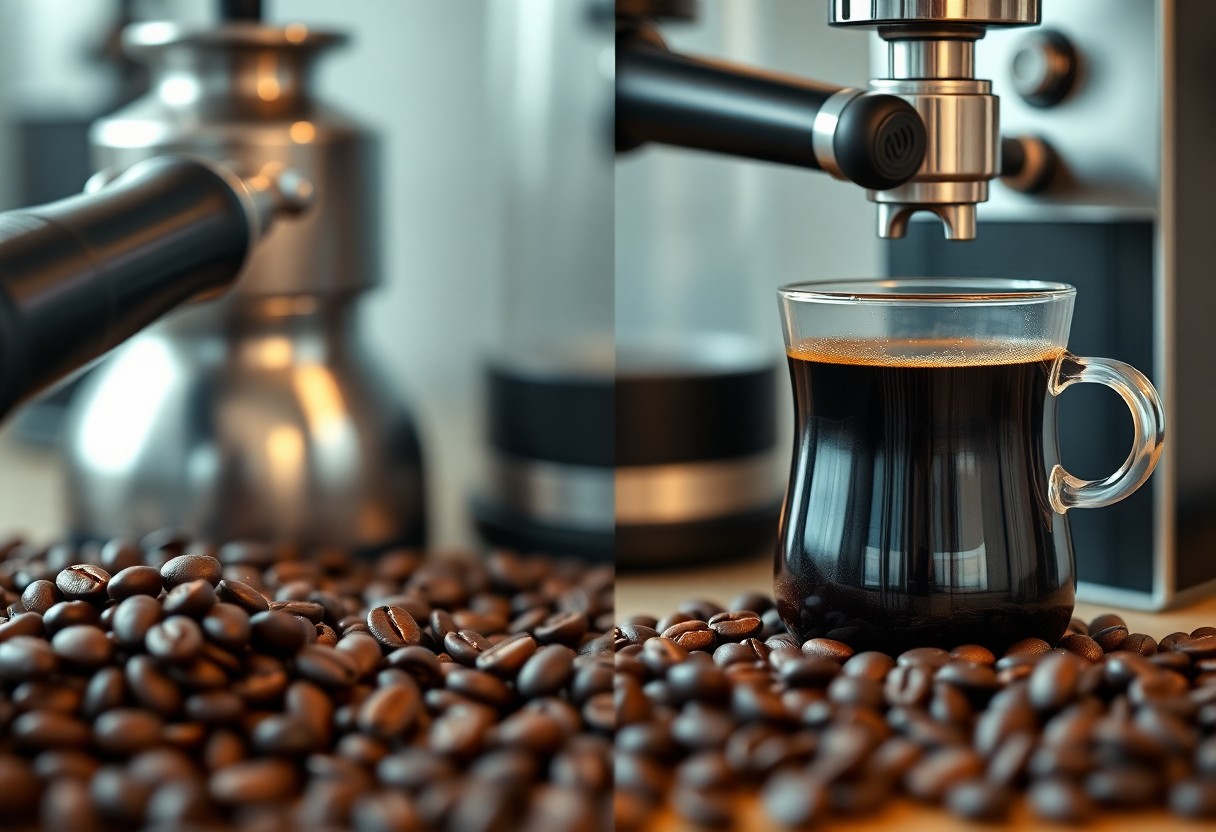While both espresso and drip coffee originate from the same coffee bean, their preparation methods and flavor profiles are quite different. Using espresso beans for drip coffee may yield a stronger, bolder flavor, but it can also result in an overly bitter taste if not handled correctly. Understanding the nuances of these beans can enhance your brewing experience and help you achieve your ideal cup. In this post, you’ll discover the pros and cons of utilizing espresso beans in your drip coffee setup, ensuring you make an informed choice for your next brew.
Key Takeaways:
- Flavor Profile: Espresso beans are often more robust and concentrated in flavor compared to drip coffee beans, resulting in a unique taste when brewed using a drip coffee maker.
- Grind Size: Espresso beans typically require a finer grind, which may affect the extraction process in a drip coffee machine, potentially leading to over-extraction and bitterness.
- Brewing Method Compatibility: While you can use espresso beans for drip coffee, it is vital to adjust the brewing time and grind size for optimal results and to avoid unwanted flavors.


Understanding Espresso Beans
For coffee enthusiasts, understanding espresso beans is key to appreciating how this coffee variety differs from others, including those used for drip brewing. The term “espresso beans” refers to coffee beans that are specifically intended for brewing espresso, which is known for its rich, concentrated flavor. Generally, most espresso beans are a blend of different beans, offering a robust taste that excites your palate. However, the actual beans, depending on their origin and composition, can be used in other forms of coffee-making as well.
What Are Espresso Beans?
Along with your usual coffee beans, espresso beans undergo a specific selection process that determines their suitability for espresso brewing. Typically, these beans come from high-quality Arabica or Robusta coffee plants, known for their unique qualities. However, the primary distinction lies not in the type of beans but in their intended preparation and brewing method.
The Roasting Process
Along with defining their flavor, the roasting process profoundly influences espresso beans. These beans are usually roasted to a darker finish than beans intended for drip coffee, which brings out a more intense flavor profile. Darker roasts often result in oils surfacing on the beans, contributing to the espresso’s signature crema and adding richness to your cup.
And when beans are roasted darker, they develop distinct flavors, often characterized by notes of chocolate, caramel, and sometimes even a hint of smokiness. Roasting at higher temperatures allows the beans to caramelize, resulting in the robust coffee taste you associate with espresso. The subtle complexities hidden within the beans come alive during this transformative process.
Flavor Profiles of Espresso Beans
Among the variety of coffee beans, espresso beans exhibit diverse flavor profiles that cater to various taste preferences. You might find espresso beans offering hints of chocolatey richness to fruity overtones, each contributing uniquely to the coffee experience. The intense brewing method accentuates these flavors, making every sip a rich exploration of taste.
Hence, the complexity of espresso flavors can significantly enrich your coffee experience. While traditionally robust and bold, you will also discover varieties that offer bright acidity or floral notes, making them a versatile choice. This characteristic diversity allows you to customize your coffee experience, whether you prefer your espresso straight or integrated into other beverages like lattes or cappuccinos.

The Drip Coffee Method
One common brewing method that coffee enthusiasts enjoy is the drip coffee method. This method involves pouring hot water over coffee grounds contained in a filter, allowing the water to extract flavors as it drips into a carafe below. It’s widely preferred for its simplicity and ability to produce a consistent cup of coffee.
What is Drip Coffee?
The drip coffee process is a straightforward way to brew coffee that involves a machine or manual setup where water is heated and dripped over ground coffee. This technique allows the water to extract the flavors and oils from the coffee grounds as it passes through, resulting in a delicious, aromatic beverage.
Brewing Techniques
The brewing techniques for drip coffee vary but generally focus on the right water temperature and brewing time. You will find that using water around 195°F to 205°F is ideal, as it enhances extraction while avoiding bitterness. The overall brewing time typically ranges from 4 to 6 minutes, which allows for optimal flavor.
In addition to water temperature and brewing time, it’s crucial to ensure an even coffee bed in the filter. This means leveling your coffee grounds before brewing, which can prevent any “channelling” and help achieve a more balanced extraction. Experimenting with these variables can lead to delightful discoveries in flavor profiles.
Optimal Coffee Grind for Drip Coffee
Coffee that’s intended for drip coffee should be ground to a medium consistency. This grind size allows for a balanced extraction without over-extracting the flavors, which can lead to a bitter taste. You’ll want the texture to feel similar to granulated sugar to achieve the best results.
Coffee grind size directly impacts the extraction process and, consequently, the flavor of your brew. A medium grind provides just the right amount of surface area for the water to extract the rich flavors while ensuring that it doesn’t take too long or short to brew. Make adjustments as needed based on your taste, but stick to medium for a solid starting point.
Can Espresso Beans Be Used for Drip Coffee?
Keep in mind that espresso beans can definitely be used for drip coffee, but there are a few factors to consider in terms of taste and extraction. The beans you select will affect the flavor profile of your brew, so if you’re up for an adventure, using espresso beans in your drip coffee maker could yield a unique cup that surprises your palate.
Compatibility of Espresso Beans with Drip Technique
Against common beliefs, espresso beans are versatile and compatible with drip coffee techniques. You can certainly adapt your brewing methods by using these beans, though they may not deliver the same experience as traditional drip coffee blends. Your choice of beans and how you prepare them will significantly influence the final taste.
Differences in Grind Size and Extraction
Behind the flavor differences lies the variances in grind size and extraction time. Espresso beans are typically ground much finer than those used for drip coffee, which can lead to over-extraction if not adjusted appropriately. This can result in a bitter taste that overshadows the intended subtle notes of your brew.
For instance, the grind size plays a vital role in how water interacts with the coffee. The finer grind of espresso beans may slow down extraction in a drip setup, leading to under-extraction unless adjusted properly. Conversely, if you don’t grind them coarser, you risk over-extracting, leading to unpleasant bitterness. Finding that sweet spot will require some experimentation on your part.
Experimenting with Brew Ratios
Grind size isn’t the only variable; experimenting with brew ratios can also transform how your espresso beans perform in a drip coffee maker. By adjusting the amount of coffee to water, you can tailor the richness and intensity of your brew to better suit your taste preference.
Plus, tweaking the brew ratios allows you to explore different flavor profiles. A higher coffee-to-water ratio may yield a more robust cup, while a lower ratio can create a milder flavor. This experimentation not only helps you understand your taste better but also encourages a delightful journey into the world of coffee, enabling you to craft the perfect cup with your espresso beans.
Flavor Comparison
All coffee enthusiasts know that the flavor profiles of espresso and drip coffee can be quite distinct. When considering using espresso beans for drip coffee, it’s imperative to compare these flavors to fully appreciate your brew options.
Flavor Aspects| Espresso | Drip Coffee |
| Rich, concentrated flavors | Lighter, more subtle flavors |
| Bold and intense | Balanced and smooth |
| Caramelized sweetness from pressure brewing | Natural sweetness with lower bitterness |
Taste Differences Between Espresso and Drip Coffee
Between espresso and drip coffee, you’ll find significant differences in taste. Espresso offers a rich, concentrated flavor profile that tends to be bold and intense, while drip coffee provides a more balanced and smoother experience. The brewing methods contribute to these differences, with espresso being pressure-brewed, resulting in a thicker consistency and greater depth of flavor.
Acidity Levels and Flavor Notes
For espresso and drip coffee, acidity levels and flavor notes vary greatly. Espresso typically has higher acidity and bolder flavor notes, while drip coffee tends to have a milder acidity, allowing the natural flavors of the beans to shine through.
Considering the acidity levels, espresso’s enhanced acidity can often enhance fruity and bright flavor notes, while drip coffee usually presents a more mellow and smoother profile. This difference can affect your overall drinking experience, as certain flavor nuances may be more prominent in one brew type than the other, impacting your preference.
Aroma and Retention in Drip Coffee
Acidity plays a significant role in the aroma and retention of flavors in drip coffee. Espresso’s concentrated nature means it can deliver a strong aroma that closely ties to its bold taste, whereas drip coffee’s lighter brewing method results in a more delicate aroma.
Plus, the aroma retention in drip coffee means that once brewed, the flavors can become more pronounced as they cool, offering a different tasting experience. With espresso, the aroma is intense but can dissipate rapidly due to its concentrated nature. Therefore, you might enjoy a more evolving flavor journey with drip coffee, making it ideal for leisurely sipping.
Recommendations for Best Results
To achieve the best flavor profile when using espresso beans for drip coffee, it’s important to consider a few key factors that can elevate your brewing experience.
Selecting the Right Espresso Beans
Around various regions, the flavor of espresso beans can vary significantly. For drip coffee, look for beans that have a well-balanced profile, typically medium to dark roasts. These will provide the bold flavors you crave without overwhelming bitterness.
Adjusting Brewing Time and Temperature
Adjusting your brewing time and temperature is imperative when using espresso beans in your drip coffee. Below are some guidelines:
Time and Temperature Adjustments| Brewing Time | Start with 4-5 minutes for optimal extraction. |
| Temperature | Use water heated between 195°F and 205°F. |
Adjusting these factors allows for proper flavor extraction, ensuring that your coffee remains smooth and rich. Fine-tuning the brew time and water temperature can significantly enhance the taste and overall experience of your cup.
Tips for Enhancing Flavor
Beside brewing adjustments, implementing a few tips can further elevate your drip coffee’s flavor. Here’s how:
- Use freshly ground espresso beans.
- Experiment with different coffee-to-water ratios.
- Incorporate a coffee filter designed to enhance flavor.
Recognizing these elements can deepen the complexity and enjoyment of your cup.
Best practices also include considering grind size and water quality. Using a coarser grind will help achieve a smoother extraction, while filtered water can remove elements that might negatively impact flavor. Additionally, don’t hesitate to adjust your ratios based on personal preference. Recognizing these factors will enhance your overall coffee experience.
Frequently Asked Questions
Unlike traditional coffee beans, espresso beans are roasted longer, resulting in a richer and bolder flavor. However, this does not mean you can’t use them for drip coffee. If you’re looking to experiment, using espresso beans for drip coffee can add a unique twist to your brewing process, but be mindful that the flavor profile may differ from your usual drip coffee.
Can You Mix Espresso Beans with Regular Coffee?
Espresso beans can certainly be mixed with regular coffee beans. Many coffee enthusiasts experiment with blending various beans to achieve a distinct flavor. By combining the boldness of espresso beans with the subtler notes of regular coffee, you can create a well-rounded, flavorful cup that highlights the best characteristics of both types.
What Happens If You Use Too Much Espresso Beans?
With excessive use of espresso beans, your coffee can become overwhelmingly strong and bitter. Achieving the right balance is key; if you overload your brew, the taste may become unpalatable, overshadowing the nuances of both the espresso and the regular coffee beans.
Consequently, using an abundance of espresso beans leads to a brew that might deliver a sharp bitterness and a flavor profile that lacks the complexity typically sought. You may find that the coffee has a thick, syrupy consistency, making it less enjoyable. It’s vital to pay attention to the ratio when mixing beans to enhance your coffee experience.
Are There Health Implications?
One primary concern with using too many espresso beans is the increased caffeine content that could affect your health. Consuming excessive caffeine can lead to issues such as insomnia, increased heart rate, and anxiety.
What you should know is that a high intake of caffeine may also result in dehydration and digestive problems. Therefore, it’s important to monitor your consumption and consider how these potent beans impact your overall well-being, especially if you are sensitive to caffeine. Always listen to your body and adjust your coffee choices accordingly to maintain a healthy balance.
To wrap up
As a reminder, while you can use espresso beans for drip coffee, the flavor profile may differ significantly. The robust and concentrated taste of espresso beans can lead to a richer cup, but it may overpower the subtleties you enjoy in drip coffee. Experimenting with grind size and brewing times can help you achieve a balance that suits your palate. Ultimately, it’s about personal preference, so don’t hesitate to explore both brewing methods to find what works best for you.
FAQ
Q: Can espresso beans be used for drip coffee?
A: Yes, espresso beans can be used for drip coffee. However, the results may vary in flavor and strength. Espresso beans are typically roasted darker and ground finer than regular coffee beans, which can influence the taste when brewed in a drip coffee maker. You might need to adjust the brewing time and water temperature for optimal flavor extraction.
Q: What is the main difference between espresso beans and drip coffee beans?
A: The primary difference lies in the roast level and grind size. Espresso beans are usually roasted darker, resulting in a more intense flavor, while drip coffee beans can be roasted to various levels, including light, medium, and dark. Additionally, espresso beans are ground to a finer consistency to accommodate the rapid extraction process used in espresso machines.
Q: Will using espresso beans for drip coffee change the flavor profile?
A: Yes, using espresso beans for drip coffee will likely change the flavor profile. You can expect bolder and richer flavors, which may include chocolatey or caramel notes. However, the pronounced acidity and bitterness of dark roasted coffee can also overpower milder flavors that might be present in drip coffee beans.
Q: How should I adjust the brewing process when using espresso beans for drip coffee?
A: When using espresso beans for drip coffee, consider using a coarser grind than what you’d typically use for espresso. Also, reduce the brewing time slightly to avoid over-extraction, which can lead to bitterness. Experimenting with water temperature and coffee-to-water ratios can optimize your brew to your taste preferences.
Q: Is there a specific ratio of espresso beans to water for drip coffee?
A: While personal preference plays a significant role, a general guideline is to use 1 to 2 tablespoons of ground espresso beans for every 6 ounces of water. Adjust the ratio to taste, depending on how strong you prefer your coffee. Keep in mind that the density of espresso grounds may lead to more robust flavor in your cup.
Q: Can using espresso beans for drip coffee affect caffeine content?
A: Using espresso beans for drip coffee can affect caffeine content, although it may not be as significant as you think. Typically, espresso contains more caffeine per ounce than drip coffee, but the serving sizes differ. A standard serving of drip coffee (8 ounces) usually has higher caffeine overall than a single shot of espresso (1 ounce). If you brew drip coffee with espresso beans, the total caffeine will depend on brewing time and quantities used.
Q: Are there any beans specifically labeled for espresso that should be avoided for drip coffee?
A: Generally, there are no beans that should be strictly avoided for drip coffee, even if they are labeled as espresso. However, certain blends may be designed to enhance the espresso experience, aimed at creating rich crema and full-bodied shots. Experimenting with different beans and blends rated for espresso can lead to interesting and enjoyable flavors in drip coffee, but it’s always best to choose those that align with your taste preferences.
